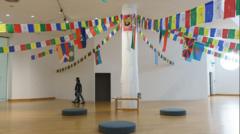How Did China Attempt to Silence a Thai Artist's Exhibition?

Transnational Repression and the Battle for Artistic Freedom
In an age where artistic expression serves as a powerful tool for social change, the recent story of Burmese artist Sai underscores the precarious nature of cultural freedom in a global context. Three weeks ago, Sai was in Bangkok, celebrating the opening of an art exhibition he had curated with his wife, only to find himself seeking asylum in the UK due to censorship pressures from the Chinese government. This harrowing journey highlights the urgent need for dialogue around transnational repression and the vital role of art in resisting authoritarianism.
The Background of the Exhibition
Opening on July 26 at the Bangkok Arts and Cultural Centre, Sai's exhibition, titled "Constellation of Complicity: Visualising the Global Machine of Authoritarian Solidarity," aimed to expose the collaborative efforts of authoritarian regimes in suppressing dissent. Featuring artists from countries like China, Russia, and Iran, the exhibition quickly drew attention from officials. Representatives from the Chinese embassy, accompanied by local officials, visited the gallery repeatedly, leading to allegations of censorship.
Initially, the Chinese officials demanded the complete shutdown of the show, claiming that it promoted independence for Tibet, Uyghur, and Hong Kong artists. Despite these pressures, the gallery managed to negotiate a compromise that allowed the exhibition to continue, albeit with significant alterations. Many sensitive artworks were removed, and descriptions of the artists' names and their homelands were blacked out, leaving a chilling mark on the artistic landscape.
The Impact of Censorship
The censorship experienced by Sai and his fellow artists has stark implications for the freedom of expression. When a government can dictate which artworks are shown in another country's cultural center, it raises serious questions about cultural sovereignty and the integrity of artistic endeavors. Works by artists like Tibetan artist Tenzin Mingyur Paldron, whose films were meant to convey heartfelt stories, were silenced under the weight of political pressure.
In light of the censorship, the exhibition gained unexpected visibility. Many in the art community rallied around the cause, and the narrative of repression has sparked discussions on social media, amplifying the voices of those who stand against authoritarianism. The incident serves as a reminder of the power of art to incite conversation and inspire activism, especially when faced with oppressive forces.
Fleeing for Safety
As the situation escalated, Sai and his wife realized they were in danger. After receiving alerts from gallery staff about police inquiries regarding their whereabouts, they decided to flee Thailand. This decision was not made lightly; the couple had already faced significant challenges, having fled their homeland in Myanmar following a military coup in 2021. Sai's activism against the junta had put him and his family in jeopardy, and now they were confronted with the threat of deportation back to Myanmar.
In a matter of hours, they packed their belongings and boarded a flight to the UK, leaving behind not just their home but the art exhibition that had become a focal point for discussions on repression and cultural expression. The couple's journey reflects the grim reality many artists face when navigating the complex interplay of politics, culture, and personal safety.
The Broader Context of Transnational Repression
The situation faced by Sai and his wife is part of a broader pattern of transnational repression, where authoritarian regimes extend their reach beyond their borders to silence dissenting voices. Human rights advocates have condemned the censorship of Sai's exhibition as a stark example of this disturbing trend. The pressure exerted by the Chinese government on Thai authorities raises questions about the complicity of host nations in such acts of repression.
Lord Alton of Liverpool, chair of the UK Parliament's Joint Committee on Human Rights, emphasized that the pressure to censor artistic expression in a foreign country is a violation of fundamental freedoms. The incident has highlighted the urgent need for international solidarity in defending artistic independence and the freedoms that underpin it.
Art as a Form of Resistance
In the wake of censorship, Sai and his wife remain committed to showcasing the uncensored version of their exhibition in other countries. They believe that the fallout from the censorship has inadvertently increased interest in their work, fueling discussions around artistic freedom and the challenges posed by authoritarian regimes. "We didn't start this movement, the CCP started it," Sai remarked, reflecting on how the censorship has galvanized support for their cause.
Art has always been a medium for resistance, and in this case, it serves as a powerful reminder that creative expression can challenge the narratives imposed by oppressive governments. The ability to share stories and experiences through art fosters a sense of global solidarity, encouraging individuals to stand up against injustice.
Conclusion: The Fight for Artistic Freedom Continues
The journey of Sai and his wife exemplifies the precarious situation faced by artists in an increasingly repressive world. Their story underscores the need for vigilance in protecting artistic freedoms and the fundamental rights of individuals to express themselves without fear of retaliation. As they navigate their new life in the UK, their commitment to raising awareness about the struggles of artists under authoritarian regimes remains unwavering.
The fight for artistic freedom is far from over. As communities around the world continue to confront the realities of transnational repression, it is crucial that we support those who use art as a means of resistance. How can we collectively amplify the voices of artists like Sai and ensure that their stories are heard and shared? #ArtForFreedom #TransnationalRepression #CensorshipResistance
FAQs
What is transnational repression?
Transnational repression refers to the efforts by authoritarian regimes to target and suppress dissenting voices beyond their borders, often through intimidation, harassment, or censorship.
How does censorship affect artistic expression?
Censorship stifles creativity and prevents artists from freely expressing their ideas, often leading to self-censorship and a chilling effect on the art community.
What can be done to support artists facing repression?
Supporting organizations that advocate for artistic freedom, sharing the stories of suppressed artists, and promoting dialogue around the importance of free expression are critical steps in combating repression.
Published: 2025-08-15 22:42:23 | Category: technology



